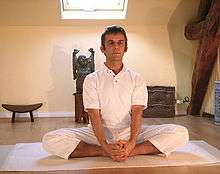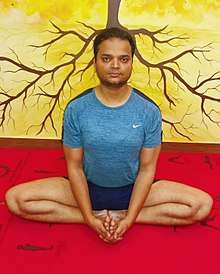Baddha Koṇāsana
| Etymology | |
|---|---|
| Sanskrit | बद्धकोणासन |
| Devanagari | बद्ध कोणासन |
| Meaning | Bound Angle Posture |
| Key Points | |
| Variations | Supta Baddha Koṇāsana |
| Effects summary |
|
Baddha Konasana (/ˈbɑːdɑː
Etymology
The name comes from the Sanskrit words baddha (बद्ध, baddha) meaning "bound", kona (कोण, koṇa) meaning "angle" or "split",[4] and Asana (आसन, Āsana) meaning "posture" or "seat".[5]
Description
From sitting position with both the legs outstretched forward, hands by the sides, palms resting on the ground, fingers together pointing forward, the legs are hinged at the knees so the soles of the feet meet. The legs are grasped at the ankles and folded more until the heels reach the perineum. The knees remain on the ground, the body erect and the gaze in front. The asana is held before coming back to the starting position. The thighs are stretched with care.


Benefits
It is a strong groin- and hip-opener and one of the few asanas that can be practiced comfortably soon after eating as long as the head is not rested on the floor. The asana is specially recommended for those suffering from urinary disorders. The pelvis, the abdomen and the back are stimulated by a plentiful blood supply.[6][7]
It relieves sciatic pain and prevents hernia. If practised regularly, it relieves pain and heaviness in the testicles. For women, coupled with Sarvangasana, it checks irregular menses and helps the ovaries to function properly.[8] Regular practise of this asana may be beneficial for the lumbar region, flat feet, high blood pressure, infertility and asthma.[9]
Precautions
While doing the asana, take care that:[7]
- This asana should be avoided in case of Groin or knee injury.
- Be careful while bending if you suffer from High blood pressure or any cardiac problems.
- Be slow and careful while doing the asana as in almost all the yoga asanas, as being quick is not what is called for in any yogic Asanas.
- Baddha Konasana should be avoided by ladies if menstruating or should be performed under guidance of a yoga expert during those days.
Variations
Supta Baddha Koṇāsana,[10] Cobbler's Pose in Lying Position, supta (सुप्त) meaning "supine" or "reclining".
See also
References
- ↑ Budilovsky, Joan; Adamson, Eve (2000). The complete idiot's guide to yoga (2 ed.). Penguin. p. 196. ISBN 978-0-02-863970-3. Retrieved 11 April 2011.
- ↑ "Yoga Journal - Bound Angle Pose". Archived from the original on 12 May 2011. Retrieved 2011-04-09.
- ↑ Claire, Thomas (2003). Yoga for Men: Postures for Healthy, Stress-Free Living. Career Press. p. 170. ISBN 978-1-56414-665-6. Retrieved 9 April 2011.
- ↑ "Baddha Konasana A - AshtangaYoga.info". Retrieved 2011-04-11.
- ↑ Sinha, S.C. (1 June 1996). Dictionary of Philosophy. Anmol Publications PVT. LTD. p. 18. ISBN 978-81-7041-293-9. Retrieved 9 April 2011.
- ↑ Kiltz, Dr. Rob (October 15, 2010). "The Health Benefits of Baddha Konasana (Bound Angle Pose)". www.cnyhealingarts.com. Retrieved 16 July 2013.
- 1 2 "Baddha Konasana". evaidyaji. Retrieved 16 July 2013.
- ↑ Iyengar, B. K. S. (1 October 2005). Illustrated Light On Yoga. HarperCollins. ISBN 978-81-7223-606-9. Retrieved 20 February 2012.
- ↑ Pederson, Kevin. "Health Benefits Of Bound Angle Pose (Baddha Konasana)". yogawiz.com/. yogawiz.com/. Retrieved 16 July 2013.
- ↑ Bhagat (2004). Alternative Therapies. Jaypee Brothers Publishers. p. 40. ISBN 978-81-8061-220-6. Retrieved 9 April 2011.
Further reading
- Iyengar, B. K. S. (1 October 2005). Illustrated Light On Yoga. HarperCollins. ISBN 978-81-7223-606-9. Retrieved 9 April 2011.
- Saraswati, Swami Satyananda (1 August 2003). Asana Pranayama Mudra Bandha. Nesma Books India. ISBN 978-81-86336-14-4. Retrieved 9 April 2011.
- Saraswati, Swami Satyananda (January 2004). A Systematic Course in the Ancient Tantric Techniques of Yoga and Kriya. Nesma Books India. ISBN 978-81-85787-08-4. Retrieved 9 April 2011.